小学英语阅读课说课稿
小学英语说课稿范文(优秀9篇)
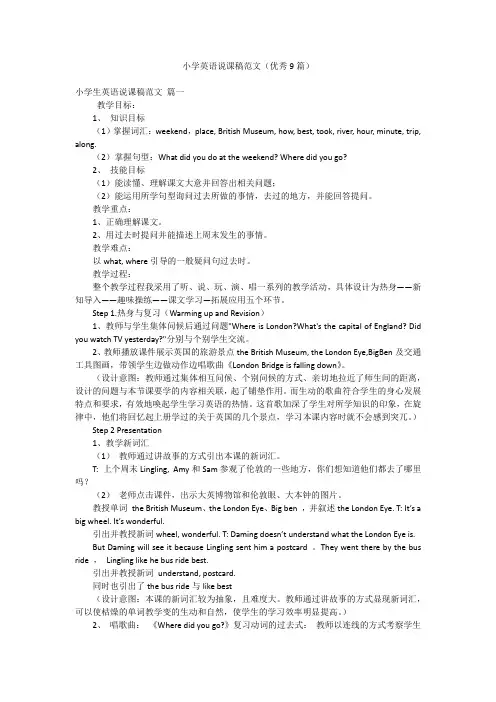
小学英语说课稿范文(优秀9篇)小学生英语说课稿范文篇一教学目标:1、知识目标(1)掌握词汇:weekend,place, British Museum, how, best, took, river, hour, minute, trip, along.(2)掌握句型:What did you do at the weekend? Where did you go?2、技能目标(1)能读懂、理解课文大意并回答出相关问题;(2)能运用所学句型询问过去所做的事情,去过的地方,并能回答提问。
教学重点:1、正确理解课文。
2、用过去时提问并能描述上周末发生的事情。
教学难点:以what, where引导的一般疑问句过去时。
教学过程:整个教学过程我采用了听、说、玩、演、唱一系列的教学活动,具体设计为热身——新知导入——趣味操练——课文学习—拓展应用五个环节。
Step 1.热身与复习(Warming up and Revision)1、教师与学生集体问候后通过问题"Where is London?What's the capital of England? Did you watch TV yesterday?"分别与个别学生交流。
2、教师播放课件展示英国的旅游景点the British Museum, the London Eye,BigBen及交通工具图画,带领学生边做动作边唱歌曲《London Bridge is falling down》。
(设计意图:教师通过集体相互问候、个别问候的方式、亲切地拉近了师生间的距离,设计的问题与本节课要学的内容相关联,起了铺垫作用。
而生动的歌曲符合学生的身心发展特点和要求,有效地唤起学生学习英语的热情。
这首歌加深了学生对所学知识的印象,在旋律中,他们将回忆起上册学过的关于英国的几个景点,学习本课内容时就不会感到突兀。
)Step 2 Presentation1、教学新词汇(1)教师通过讲故事的方式引出本课的新词汇。
小学英语说课稿(精选6篇)
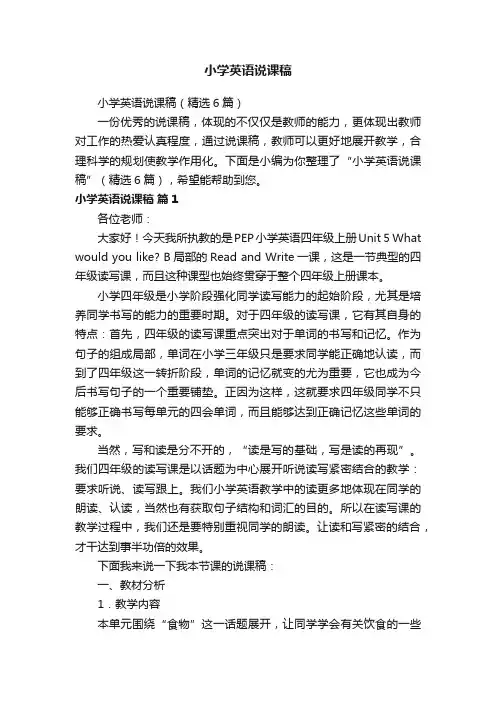
小学英语说课稿小学英语说课稿(精选6篇)一份优秀的说课稿,体现的不仅仅是教师的能力,更体现出教师对工作的热爱认真程度,通过说课稿,教师可以更好地展开教学,合理科学的规划使教学作用化。
下面是小编为你整理了“小学英语说课稿”(精选6篇),希望能帮助到您。
小学英语说课稿篇1各位老师:大家好!今天我所执教的是PEP小学英语四年级上册Unit 5 What would you like? B局部的Read and Write一课,这是一节典型的四年级读写课,而且这种课型也始终贯穿于整个四年级上册课本。
小学四年级是小学阶段强化同学读写能力的起始阶段,尤其是培养同学书写的能力的重要时期。
对于四年级的读写课,它有其自身的特点:首先,四年级的读写课重点突出对于单词的书写和记忆。
作为句子的组成局部,单词在小学三年级只是要求同学能正确地认读,而到了四年级这一转折阶段,单词的记忆就变的尤为重要,它也成为今后书写句子的一个重要铺垫。
正因为这样,这就要求四年级同学不只能够正确书写每单元的四会单词,而且能够达到正确记忆这些单词的要求。
当然,写和读是分不开的,“读是写的基础,写是读的再现”。
我们四年级的读写课是以话题为中心展开听说读写紧密结合的教学:要求听说、读写跟上。
我们小学英语教学中的读更多地体现在同学的朗读、认读,当然也有获取句子结构和词汇的目的。
所以在读写课的教学过程中,我们还是要特别重视同学的朗读。
让读和写紧密的结合,才干达到事半功倍的效果。
下面我来说一下我本节课的说课稿:一、教材分析1.教学内容本单元围绕“食物”这一话题展开,让同学学会有关饮食的一些句子和习惯用语,如What would you like for dinner? I’d like…本课重点让同学掌握四个有关食物的四会单词rice,beef,fish,chicken。
这四个单词同学们在A局部的Let’s learn中已经学过,因此我上课之前以歌曲和菜单的形式让同学复习一下本课的四会单词。
小学英语说课稿(英文版)范例【五篇】
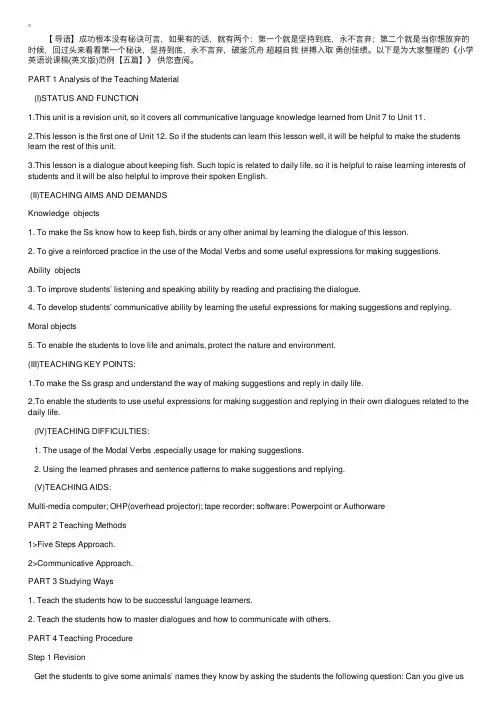
【导语】成功根本没有秘诀可⾔,如果有的话,就有两个:第⼀个就是坚持到底,永不⾔弃;第⼆个就是当你想放弃的时候,回过头来看看第⼀个秘诀,坚持到底,永不⾔弃,破釜沉⾈超越⾃我拼搏⼊取勇创佳绩。
以下是为⼤家整理的《⼩学英语说课稿(英⽂版)范例【五篇】》供您查阅。
PART 1 Analysis of the Teaching Material(I)STATUS AND FUNCTION1.This unit is a revision unit, so it covers all communicative language knowledge learned from Unit 7 to Unit 11.2.This lesson is the first one of Unit 12. So if the students can learn this lesson well, it will be helpful to make the students learn the rest of this unit.3.This lesson is a dialogue about keeping fish. Such topic is related to daily life, so it is helpful to raise learning interests of students and it will be also helpful to improve their spoken English.(II)TEACHING AIMS AND DEMANDSKnowledge objects1. To make the Ss know how to keep fish, birds or any other animal by learning the dialogue of this lesson.2. To give a reinforced practice in the use of the Modal Verbs and some useful expressions for making suggestions.Ability objects3. To improve students’ listening and speaking ability by reading and practising the dialogue.4. To develop students’ communicative ability by learning the useful expressions for making suggestions and replying. Moral objects5. To enable the students to love life and animals, protect the nature and environment.(III)TEACHING KEY POINTS:1.To make the Ss grasp and understand the way of making suggestions and reply in daily life.2.To enable the students to use useful expressions for making suggestion and replying in their own dialogues related to the daily life.(IV)TEACHING DIFFICULTIES:1. The usage of the Modal Verbs ,especially usage for making suggestions.2. Using the learned phrases and sentence patterns to make suggestions and replying.(V)TEACHING AIDS:Multi-media computer; OHP(overhead projector); tape recorder; software: Powerpoint or AuthorwarePART 2 Teaching Methods1>Five Steps Approach.2>Communicative Approach.PART 3 Studying Ways1. Teach the students how to be successful language learners.2. Teach the students how to master dialogues and how to communicate with others.PART 4 Teaching ProcedureStep 1 RevisionGet the students to give some animals’ names they know by asking the students the following question: Can you give ussome names of different animals you know? This step is employed to revise the words related the animals. At the same time draw the students’ attention to the topic about animals.Step 2 Lead-inSign to the students to be quiet and close their books. Then start a free talk with the students. Use computer to show some pictures of different pets, such as dogs, cats etc. Ask the students several questions about raising pets. These questions are employed to warm up the students and raise the interests of the students to speak English in class on the topics they like and familiar with.Good morning, everyone!Today, I’ll say something about Unit 9 Part A in Book 4 of Oxford English.Background on the reformation of curriculum, this book can connect the life and act, emphasize the interest and experience of the Ss, the pictures are active and vivid. Grade four is the initial stage of English learning, so it stresses on the emotion of the Ss, creates a well beginning for the Ss. This Unit has 7 parts, we’ll learn Part A mainly, it embodies the repeating characterize. Review the learned language points “Where’s…”and the new language points will be represented in the following units. So this unit forms connecting links with a special meaning in this book.The content of this period is to use “Where’s\are…” to determine the place. And according to the contents and the fact of the Ss, I establish the following three teaching aims of this period:The first one: students can listen, read, say and spell the following words: a glass, a fridge, an egg, bread and a table.The second one: students can listen, read, say and write the following daily expressions: What’s for breakfast?Have some juice then.The third one: students can listen, read, say and write the following sentence patterns: Where’s\Where are the\my…It’s \They’re…There’s no …in \on \near…I think the most difficult point of this period is to make sure the students can use the patterns “Where’s\Where are…and There is no …in\on\near…” in their daily life correctly.And I will use some pictures, words and sentence cards, a tape recorder and the multi-media computer to help me achieve the aims.The task-based method, communicated method, group cooperate method will be used in this period.To accomplish the aims, I design the following steps:Step 1 Songs and the game arousers the emotion.In order to attract the Ss’ attention and construct an atmosphere of learning English, I let the students sing some English songs and play the game “Simon says”. At the same time the game can review the prep, serve the knowledge as foil and consist the appearance of the knowledge.Step 2 Change class to life, happy to say.The substance of language is communication and the environment of communication is life. So when I present the sentence pattern “What’s for breakfast?” I first show a clock to elicit the time for breakfast, teach the sentence. Then show my own photo of having breakfast, Ss ask and guess. In this way I can attract Ss’ attention, encourage Ss to ask Qs with the new knowledge.Most of the Ss have learnt the sentence pattern: Where’s…? so I design a task for Ss to help Helen find the food and drinks for breakfast, and teach the new language points: Where are…?They’re … Meanwhile stick the sentences on the Bb.After some practice by asking and answering, I present the next language points:There’s no …in\on\near…Have …then.And I will stick these sentence patterns on the Bb. Finally I’ll let the Ss do pair works to consolidate them.Step 3 Listen to the tape and Ss imitate to read and say.As the new reformation of curriculum, emphasized the traditional class attach importance to the mechanical teaching, neglect the experience and participation, for example, the five-step method. So in this lesson, after presentation, I ask Ss to listen to the tape with three Qs, read in different roles and in pairs, then try to recite the text.Step 4 Ss be the main body, T makes a guider.In class, Ss play as a host, and the T makes an influence on guiding, help Ss to act the learnt dialogue, it can stress the position of the Ss, and arouse their interest.Then I show a carton with no voice, ask Ss to make a dialogue in pairs.There are lots of ways to consolidate the new knowledge. Playing game is a good way. So according to the physiology of Ss, I hold a group competition during the game, ask Ss to finish the blanks. In this way can develop Ss’ good habits and achieve the aim of mastering the learned knowledge in situation.Step 5 Change class to life, learn by themselves.Is this the end of the class? I don’t think so. If there is an end, I think it should be in the life. So I extend this class, encourage Ss to use the learned to communicate with each other in their life.In a word, the whole period is based on tasks, which are designed from easy steps to steps that are challenging. When the Ss are carting out the tasks, they can acquire information, knowledge, and have their ability and skills trained.Thank you!。
小学英语阅读课说课稿英文版
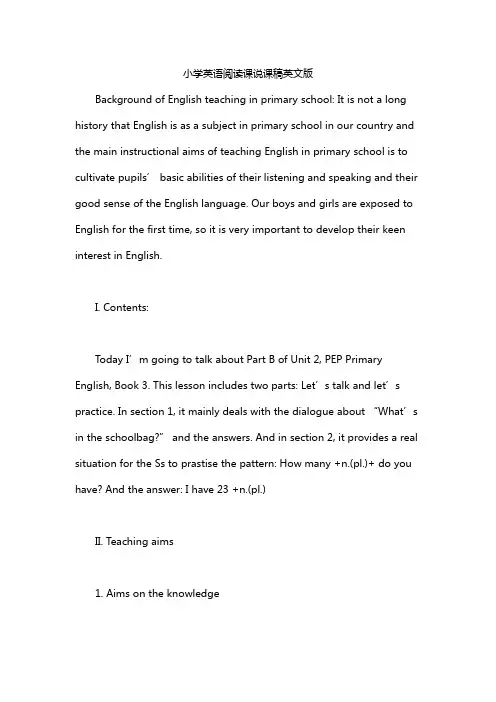
小学英语阅读课说课稿英文版Background of English teaching in primary school: It is not a long history that English is as a subject in primary school in our country and the main instructional aims of teaching English in primary school is to cultivate pupils’ basic abilities of their listening and speaking and their good sense of the English language. Our boys and girls are exposed to English for the first time, so it is very important to develop their keen interest in English.I. Contents:Today I’m going to talk about Part B of Unit 2, PEP Primary English, Book 3. This lesson includes two parts: Let’s talk and let’s practice. In section 1, it mainly deals with the dialogue about “What’s in the s choolbag?” and the answers. And in section 2, it provides a real situation for the Ss to prastise the pattern: How many +n.(pl.)+ do you have? And the answer: I have 23 +n.(pl.)II. Teaching aims1. Aims on the knowledge(1) To enable the Ss to un derstand and speak: “My schoolbag is heavy. What’s in it? Thank you sooooooo much.” Make sure that Ss can use these sentences in real situations.(2) To help Ss to finish the survey.(3) Let Ss finish the assessment of “Let’s check” in this unit.2. Aims on the abilities(1) To develop Ss’ abilities of listening and speaking.(2) To train the Ss’ ability of working in groups.(3) To foster Ss’ abilities of communication and their innovation.3. Aims on the emotion(1)To foster Ss’ consciousness of good co-operation and proper competition.(2) To lead Ss to show their loveliness to the poor.III. Key-points of this lesson(1) To help Ss ask and answer the question: What’s in it?(2) To enable Ss to study in groups and co-operate skillfully.(3) To develop Ss’ interest in English.IV. Difficult points(1) To help the Ss ask and answer the question “What’s in it?” and make sure they can use the plural nouns correctly.(2) To finish the survey by themselves.V. Teaching methodsAs we all know: the main instructional aims of learning English in primary school is to cultivate pupils’ basic abilities of listening and speaking and their good sense of the English language. So in this lesson I’ll mainly use “Task-based” teaching method. That is to say, I will letthe Ss learn in real situations, finish a task by making a survey to help the Ss to get a better understanding of the key structure of the dialogue. I will arrange four kinds of activities: singing, guessing game, finishing a survey and having a competition. And in this lesson a recorder, CAI, school things and a printed form will be needed. Students should prepare some school things.VI. Teaching procedures and purposes of my designing.I’ll finish this lesson in five steps.Step 1. Warm-up and preview1. Free talk between T and Ss about things in the classroom.2. Sing the song together: Books and pencils.3. Do some TPR, for example: Show me your English book. Show me your crayon.4. Review the numbers by asking: “How many crayons do you have?”Purpose: It is important to form a better English learning surrounding for the Ss by singing and doing some total physical response and at the same time it provides situations to review learned knowledge for the next step.Step 2. PresentationNow I’ll mainly talk about this step.1. Present the pattern: “My schoolbag is heavy.” “What’s in it?.”(1) Show a bag and say: “Look! I have a bag.” Carry it and say: “Oh, it is heavy. My schoolbag is heavy.” Help the Ss understand the meaning with the help of my body language. Then lead the Ss to read the sentence. Make sure they can say it correctly.(2) T: My schoolbag is heavy.Open the bag and say: “What’s in it? What’s in my schoolbag?”Take out a Chinese book. Then do the action again. Let the Ss read the sentence.2. Play a guessing game. Divide the whole class into four groups to have a competition.Let them guess: What’s in the bag? How many? Purpose: To present the key structures one by one is much easier for the Ss to learn and grasp the meanings. Proper competition can arouse the Ss’ interest in English learning.3. With the help of the CAI to present the dialogue. Set a situation to help Ss understand: Two Ss are coming. One girl is carrying a heavy bag on her back. They are talking.Girl: My schoolbag is heavy.Boy: What’s in it?Girl: 20 story-books, 32 pencil, 9 rulers, 12 crayons and 30 picture-books. Etc.Boy: What will you do?Girl: They are for the poor.Bo y: Great! I’ll bring some school things too.The boy comes back home and puts a lot of things into the bag. Then he goes to school again and gives them to a teacher. While he is taking them out, he is counting the numbers of all things. The teacher says: Thank you soooooooo much.4. Mention that we should take care of the poor.5. Play the cassette. Let the Ss listen and imitate the dialogue.Pay attention to their pronunciation and intonation. Purpose: CAI can provide a real situation for the Ss to understand the dialogue and the relationships between people better. Tell the Ss we should show our loveliness to the Ss.Step 3. PracticeDivide Ss into groups of six children. Each one would finish the printed form by asking and answering: How many storybooks do you have? Find out which group finishes faster. Story books picture-books sharpeners crayons pencils erasers pencil-cases rulers Chen Jie 8 24 3 32 26 4 1 3 Purpose: Task-based teaching method is used here to develop Ss’ ability of communication and also their ability of co-operation will be well trained.Step 4. AssessmentHelp Ss finish “Let’s check” of this unit and workbook.Purpose: To check the knowledge Ss have learned in this period.Step 5. Add-activity1. Let Ss tell each other how many school things they have after class. Tell their parents how many school things they have at home.2. Take care of everything they have.Purpose: Revision is so important that Ss should speak English as much as they as in class or after class. It is necessary for the Ss to do some extensive exercises after class to consolidate the knowledge they learned.。
说课稿小学英语阅读模板
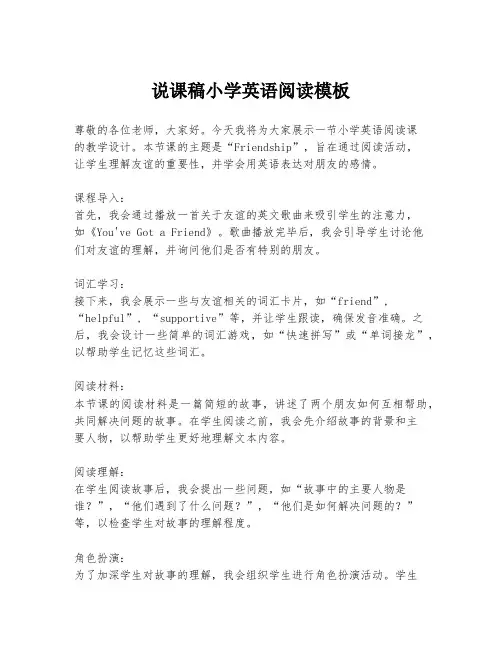
说课稿小学英语阅读模板尊敬的各位老师,大家好。
今天我将为大家展示一节小学英语阅读课的教学设计。
本节课的主题是“Friendship”,旨在通过阅读活动,让学生理解友谊的重要性,并学会用英语表达对朋友的感情。
课程导入:首先,我会通过播放一首关于友谊的英文歌曲来吸引学生的注意力,如《You've Got a Friend》。
歌曲播放完毕后,我会引导学生讨论他们对友谊的理解,并询问他们是否有特别的朋友。
词汇学习:接下来,我会展示一些与友谊相关的词汇卡片,如“friend”, “helpful”,“supportive”等,并让学生跟读,确保发音准确。
之后,我会设计一些简单的词汇游戏,如“快速拼写”或“单词接龙”,以帮助学生记忆这些词汇。
阅读材料:本节课的阅读材料是一篇简短的故事,讲述了两个朋友如何互相帮助,共同解决问题的故事。
在学生阅读之前,我会先介绍故事的背景和主要人物,以帮助学生更好地理解文本内容。
阅读理解:在学生阅读故事后,我会提出一些问题,如“故事中的主要人物是谁?”,“他们遇到了什么问题?”,“他们是如何解决问题的?”等,以检查学生对故事的理解程度。
角色扮演:为了加深学生对故事的理解,我会组织学生进行角色扮演活动。
学生将被分成小组,每组选择一个角色,然后根据故事内容进行表演。
这不仅能锻炼学生的口语表达能力,还能让他们更深入地理解友谊的意义。
情感教育:在角色扮演活动结束后,我会引导学生讨论友谊的重要性,并鼓励他们分享自己的友情故事。
通过这种方式,学生能够更好地理解并珍惜自己的朋友。
作业布置:最后,我会布置一项作业,让学生写一篇短文,描述他们最好的朋友以及他们之间的友情故事。
这不仅能巩固学生在课堂上学到的知识,还能激发他们用英语表达自己情感的兴趣。
课程总结:在课程的最后,我会总结今天的学习内容,并强调友谊在人生中的重要性。
同时,我会鼓励学生在日常生活中多与朋友交流,培养深厚的友谊。
通过这节课,我相信学生们不仅能够学习到与友谊相关的词汇和表达方式,还能够更深刻地理解友谊的价值,并学会在生活中珍惜和维护友谊。
小学英语说课稿(精选10篇)
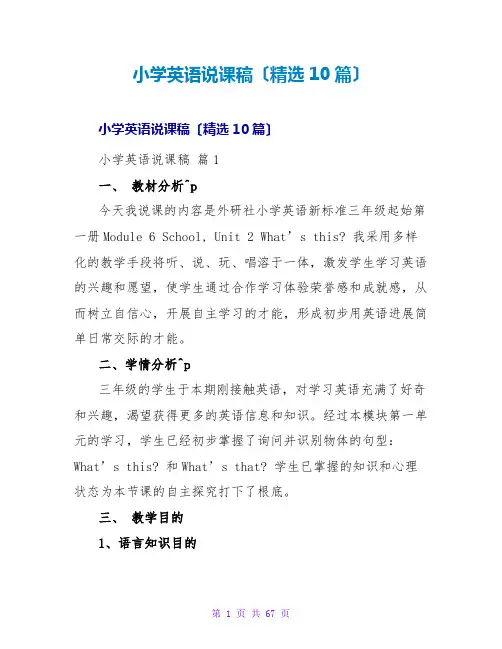
小学英语说课稿〔精选10篇〕小学英语说课稿〔精选10篇〕小学英语说课稿篇1一、教材分析^p今天我说课的内容是外研社小学英语新标准三年级起始第一册Module 6 School, Unit 2 What’s this? 我采用多样化的教学手段将听、说、玩、唱溶于一体,激发学生学习英语的兴趣和愿望,使学生通过合作学习体验荣誉感和成就感,从而树立自信心,开展自主学习的才能,形成初步用英语进展简单日常交际的才能。
二、学情分析^p三年级的学生于本期刚接触英语,对学习英语充满了好奇和兴趣,渴望获得更多的英语信息和知识。
经过本模块第一单元的学习,学生已经初步掌握了询问并识别物体的句型:What’s this? 和What’s that? 学生已掌握的知识和心理状态为本节课的自主探究打下了根底。
三、教学目的1、语言知识目的(1) 让学生能听、说、认、读pen,pencil,book,bag等单词。
(2) 通过学习让学生纯熟掌握句型What’s this? 和What’s that?2、学习技能目的:(1) 能听懂Let’s do中的指令并做出相应动作,如Point to th e …(2) 根据图片或在场景下进展简单的英语交流和表达,培养学生灵敏运用所学知识进展交流的才能.3、情感态度目的(1) 通过学习活动,使学生有兴趣听、说英语,培养学生注意观察、乐于模拟的良好习惯和主动竞争的竟识。
(2) 让学生在鼓励性评价中树立学习英语的自信心。
(3) 通过小组活动培养学生合作交流才能,从而让学生意识到学习英语的重要意义。
(4)充分利用教材所提供的学习资,实现自由参与与创新,能主动与别人交流,并克制交流中的困难,使交际顺利进展。
四、教学重难点1、学习新单词 pen,pencil,book,bag ,能正确认读。
2、稳固已学句型:What’s this? 和What’s that? 并能用It’s a…作出相应的答复。
五、课前准备教具准备:课文录音;带单词的物品图片;实物pen,pencil,book,bag;魔法包;奖品(贴画)。
小学英语英文说课稿(共6篇)
篇一:小学英语说课稿模板万能小学英语说课稿(英文万能版)● good morning, my dear judges. i am_______, from____________.i’m glad to interpret my teaching design here.● the teaching content is part, of unit of pepprimary english, bookthis unit is mainly about now, i will explain the lesson from the following aspects.1. 教学内容(体现教材的整合)firstly, let’s focus on the analysis of teaching content.the lesson is a new one of unit .it includes and . insection 1, it mainly deals with these key words,2. 教学对象(根据不同年级的学生,描述其特点)secondly, it is about the students.our students are in gradethey are active and curious, interested in new things.after learning english for years, they have some basic englishbackground knowledge, so the teacher should attach importance to thethey have learnt english for years, and have already known it is not difficult for them to understand and use the language 3. 教学目标(根据具体内容定目标和要求)so, i set the following aims.by the end of the lesson, students will be able to read, recognize, and usethese words:and, these sentences:by the end of the lesson,ss can understand the and get useful information from the throughattentive listening / reading.ss are able to talk about ss can use to give suggestions onss’ abilities of listening and speaking will be developed.(affect; learning strategies; cultural awareness.)in this lesson, the emotional aim isto help students cultivate and foster their abilities of working ingroups.to foster ss’ consciousness of good-cooperation and properto help ss cultivate their abilities to analyze and solve problemsindependently.to foster ss’ initiative and creativeness.to make sure that ss can use correctlyskillfully.to develop ss’ interest in english.the difficult point is:the pronunciation of 教法学法fourthly, it talks about teaching methods.andin this lesson, i will mainly use “task-based teaching method”,and so on.4. 教学过程①具体steps 根据具体内容定;②板书steps + purpose 说明;③如有可能,同时完成layout设计;next, let’s focus on the teaching procedures.i will finish the lesson in steps.it will cost about mins.after greeting with the ss, i will begin the lesson by singing the song together with the ss.purpose:the purpose of this is to form a better english learning surrounding forthe ss, and, at the same time, it provides situations to review the learnt knowledgefor the next step.it will cost about mins.with the help of the ppt, i set a situation of by to stimulate the ss’ interest of the lesson.by playing the ppt, iand then, (板书layout)the purpose of this is to present the new words and sentences in thesituation, which relates to the ss’ real life experiences, to help the ss understand the language easily and naturally.after presenting each new word (by the guessing game), i will impart theknowledge of pronunciation rules in teaching the new words.it is called phonics.it can facilitate the ss’ abilities to pronounce the words, and help them to remember the spelling of the words.(机械上口;有意义操练; let’s do; 课文对话表演;)it will cost mins, includingdue to the ss’ age, i make the purpose of this is to draw the whole ss’ attention to the spelling ofthe words.it is to help ss to learn through a true situation.in this step, i will give ss a free space to show their abilities.i willthen,used here.ability of cooperation will be well developed.making a new dialogue is to check if ss can use correctly and skillfully.(总结上课内容;德育渗透;作业布置;)in this step, i will guide the ss to conclude the key words and sentences and also, i will the purpose of this is to stimulate ss’ interest of learning english and5. 板书设计and, this is my layout design.that’s all for my teaching design. thank you a lot for listening. (gong) 篇二:小学英语说课稿:《what do you like》说课稿范文小学英语说课稿:《what do you like》unit 11 what do you like?说课稿1.说教材1.1教材内容本节教材的主要话题是food,功能为运用i like?.句型表达自己喜好什么食物,并在此基础上进行简单的语言交流。
小学英语说课稿优秀7篇
小学英语说课稿优秀7篇英语说课稿篇一一.教材分析本单元以“Fun places”为话题,旨在通过单元教学,帮助学生掌握描述过去经历的功能句式,学习现在完成时的用法,并能区别现在完成时和一般过去时在表述过去经历时的不同。
在本单元中,学生还将通过阅读训练,了解一些有趣的地方,例如Disney和Singapore,在语篇中进一步理解目标语言,学习生词。
Reading Section 1以小组讨论的方式,谈谈西方著名城市,激发学生了解世界的愿望;Section 2帮助学生掌握一个重要的阅读技巧,即通过阅读反思获取信息;Section 3以填空,添词和纠错等练习形式加强学生对阅读内容的理解;Section 4要求学生为自己的家乡或已去过的地方创作一则广告;If you have time!要求学生想出至少5件自己做过的不平常的事件并与同学们进行交流,将已学过的知识应用于实际生活并拓展知识。
二.教学目标1.学生能运用读后反思的阅读策略记录阅读的要点,以便对阅读的内容记得更持久。
2.通过学习,学生对新加坡有个大致的整体的认识。
3.学习后,学生能为某个地方写旅游广告。
三.教学过程:1.向学生介绍一些国家和城市的特色,问学生是否想去?为什么想去?2.问“狮子城”去过吗?引出此课的主题Have you ever been to Singapore?学生没去过。
接着因势利导,若想去就要了解关于新加坡的一些有趣的东西。
让学生快速默读课文,读后反思本文的关于新加坡的重要方面提到了哪些。
3.逐段让学生回答问题,设置关于每段的中心以及一些体现该段重点的问句。
4.细致处理每段,在屏幕上展示每段文字,让学生根据汉语意思很快想出对应的英语单词并拼写出来。
此步骤对学生的要求有点难,一些长单词他们不能很快拼写对,因为时间很短课文较陌生。
5.阅读了此课文,学生对新加坡有了整体的了解。
让他们用几分钟时间为新加坡写一则旅游广告。
这培养了学生综合语言能力。
小学英语pep阅读部分说课稿
小学英语pep阅读部分说课稿小学英语PEP阅读部分的教学设计需要充分考虑学生的语言基础、认知水平和兴趣点。
以下是一份小学英语PEP阅读部分的说课稿,供参考:# 教学目标1. 知识目标:学生能够理解阅读材料的主旨大意,识别关键词汇和句型。
2. 技能目标:培养学生的阅读理解能力,包括快速浏览、寻找信息、推断词义等。
3. 情感目标:激发学生对英语阅读的兴趣,增强学习英语的自信心。
# 教学内容本次课程的阅读材料选自PEP小学英语教材,内容涉及日常生活、校园活动或简单的科普知识。
# 教学重点1. 阅读材料中的关键词汇和句型。
2. 通过上下文推断生词词义的能力。
# 教学难点1. 学生对长句和复杂句型的理解。
2. 学生在阅读中快速捕捉信息的能力。
# 教学方法1. 情景教学法:通过创设情境,帮助学生更好地理解阅读材料。
2. 任务型教学法:设计任务驱动学生主动阅读,提高阅读效率。
3. 合作学习法:鼓励学生小组讨论,共同解决问题。
# 教学过程1. 导入(Lead-in):- 通过提问或展示图片,激发学生对话题的兴趣。
- 复习与阅读材料相关的词汇和句型。
2. 呈现(Presentation):- 向学生展示阅读材料,解释生词和难句。
3. 练习(Practice):- 学生独立阅读,完成教师设计的阅读任务,如填空、选择、回答问题等。
- 小组合作,讨论阅读材料中的问题。
4. 产出(Production):- 学生根据阅读材料进行角色扮演或复述故事。
- 学生进行小组讨论,分享阅读心得。
5. 总结(Summary):- 教师总结学生在阅读中遇到的问题和解决方法。
- 强调阅读技巧的重要性。
6. 作业(Homework):- 布置相关的阅读练习,鼓励学生在课外进行自主阅读。
# 教学媒体与教具- 多媒体课件:包含阅读材料、图片、音频等。
- 黑板:用于板书关键词汇和句型。
- 阅读卡片:用于快速检测学生对词汇的掌握。
# 教学反思课后,教师应根据学生的反馈和表现,反思教学方法和内容的适宜性,不断调整教学策略,以满足不同学生的学习需求。
小学六年级英语说课稿5篇
【导语】⼀份优秀的说课稿,体现的不仅仅是教师的能⼒,更体现出教师对⼯作的热爱认真程度,通过说课稿,教师可以更好地展开教学,合理科学的规划使教学作⽤化。
以下是整理的《⼩学六年级英语说课稿5篇》相关资料,希望帮助到您。
1.⼩学六年级英语说课稿 ⼀、说教材。
1、教材的地位及作⽤。
本课主要学习了⼀些新的⾷物单词,要求掌握句型Taste this. It's sour/sweet. 本课是本单元的第⼆课,前⼀课已学习了What's this?这⼀句型,在这⼀课中⼜得到了巩固,在本单元中起着承上启下的作⽤。
2、教学⽬标的确定及其依据。
根据学⽣已有的认知基础及本课在单元中的地位及作⽤,依据⼩学英语教学的总体⽬标,确⽴本课的教学⽬标为: (1) 能听懂会说本课的会话。
(2) 能较好地掌握本课句型Taste this . It's sour /sweet. (3) 掌握有关⾷物的词汇。
3、教学重点与难点。
本课教学的重点是调动学⽣的主动性,使其⼤胆开⼝,积极参与语⾔的实际交际,培养学⽣学习英语的兴趣及⽤英语思维的习惯。
根据⼩学英语教学的要求,学⽣的年龄特点及认知规律,本节课的教学难点是让学⽣在看看、说说、玩玩中增强对语⾔的感受,在愉快和谐的氛围中学习英语。
4、教材的处理。
(1) 会话教学内容以创设情境、表演为主,体现语⾔的交际功能。
(2) 词汇教学内容要求学⽣能听能说。
⼆、说教法。
⼩学英语教学应把培养学⽣的学习兴趣,调动学⽣学习英语的主动性、积极性作为教学的主要⽬的。
在本课教学中以情景教学为主。
并通过游戏、竞赛等形式激发学⽣的兴趣,使每位学⽣都能积极地参与进来。
三、说教学程序。
本课分4个步骤来完成。
1、组织教学,引⼈⼊胜。
从⼼理学⾓度讲,学⽣刚上课时⼼理处于紧张消极状态,通过⽤英语与学⽣打招呼,和他们⼀起唱英语歌曲来组织教学,结合前⾯所学课⽂内容进⾏师⽣对话,可以活跃课堂⽓氛,消除紧张⼼理,使学⽣很⾃然地进⼊良好的学习状态。
- 1、下载文档前请自行甄别文档内容的完整性,平台不提供额外的编辑、内容补充、找答案等附加服务。
- 2、"仅部分预览"的文档,不可在线预览部分如存在完整性等问题,可反馈申请退款(可完整预览的文档不适用该条件!)。
- 3、如文档侵犯您的权益,请联系客服反馈,我们会尽快为您处理(人工客服工作时间:9:00-18:30)。
小学英语阅读课说课稿篇一:小学英语优秀说课稿《Unit 1 This Is My Day 》(借鉴参考)Unit 1 This Is My Day尊敬的各位评委老师,大家上午好。
今天很荣幸站在这里说课,我是小学英语组??考生。
今天我说课的内容是Unit1 This Is My Day (说完了就立刻板书)。
接下来我将从教材的分析、学情的分析、教法学法的选用、教具的准备、教学过程的设定和板书设计这六个方面来呈现我的说课。
一、说教材第一个版块说教材,包含三个要点首先说教材地位与作用:本课内容选自人教版英语五年级下册,单元核心内容是学习一天中不同时间段内的学习和生活起居情况的表达,尤其是学会使用频度副词谈论日常生活。
本课时是A部分的Let’s Learn 和Let ’s play,是本部分的第一课时,它是整个模块的重点,占有很重要的地位,为后面课时的学习做铺垫。
然后说教学目标:根据课程标准对本节课的具体要求,针对小学生的心理特点和认知水平,结合教材,本着面向全体学生,使学生全面主动发展的原则,确定本节课的教学目标如下:1、知识目标:掌握本课时主要动词短语:eat breakfast,do morning exercises,have English class,play sports,eat dinner。
2、能力目标:能够听懂问句:When do you do morning exercises/...?并能运用所学动词短语替换句型“I usually ... at ...中的关键词回答问句。
3:情感目标:引导学生养成良好的作息习惯。
最后说教学重难点,其中重点是掌握Let’s learn 中的五个动词短语,并能用这五个短语回答询问作息时间的问题。
难点是掌握五个短语和单词exercises,usually 的正确发音。
二.说学请学生在上册已经对相关内容有部分了解,对时间的表达也比较熟悉,已掌握了一定数量的动词短语如do homework,play football,watch TV,play computer games 等。
因此,活动设计要激活学生的最近发展区,通过不同层次的活动使效率最大化,知识系统化、条理化,促进完整表达的输出。
三、教法,学法为实现以上教学目标,同时贯彻新课标以学生为主体、教师为主导的理念,在本课的教学中我主要采用直观教学法、TPR教学法、游戏教学法和任务型教学法。
通过这些方法,让学生自主地参与到课堂教学的活动中来,并在活动中得到认识与体验,培养良好的英语学习习惯。
结合以上教学方法,学生在学习本课时中主要采用模仿、小组比赛和及时评价法等学习方式。
以小组为单位交流,使学生在互动中互相启发,产生思维的碰撞,同时保证每个学生都有机会参与学习,从而培养学生与伙伴合作的意识与策略,提高人际交往,学生也在独立与合作中调控了自身的学习,变得自信自强。
在评价学生时,应以鼓励为主,兼顾表扬和指正,如good job ,can you have a try, try again,it doesn’t matter等鼓励学生学习,帮助学生有效调控自己的学习过程,使学生获得成就感,增强自信心。
四、教具准备录音机,磁带,书本上五个短语的词卡和图卡,已学动词短语词卡,时间卡数张五、教学过程我准备从以下五个步骤来设计这节课:step1......step2......step3.....step4.....step5......Step 1 awarming-up本步骤主要通过2个活动来完成热身准备的。
1、Englishsong 我会在课一开始就为学生播放Let’s chant部分的歌曲,让学生去感受歌曲中的节奏和韵律,把学生带入学习英语的氛围中。
2、word-game---What’s missing 我会将五张已学过的动词短语词卡贴在黑板上,要求学生根据我所读的动词短语立即跟读,接着我会从黑板上随意抽出一张动词短语词卡,问:What’s missing,然后让学生回答,换不同动词短语词卡玩几次,对表现好的学生进行表扬,如:Good job,这样有利于培养学生学习英语的积极性和兴趣。
接着游戏继续问表现好的学生,T:What do you do on Saturday mornings? 引导此生回答,I do homework 。
T:What do you do on Saturday afternoons? S:I play football。
T:What do you do on Saturday night? S:I watch TV。
T:So is this your day? S:Yes ,this is my day,从而导入本单元主题。
Step 2 presentation这个步骤我设计了两个活动1、展示已学动词短语词卡watch TV问:When do you watch TV? 出示时间卡引导学生回答,I usually watch TV at 2:30.出示eat breakfast的图卡问学生,When do you eat breakfast,出示时间卡引导学生回答,I usually eat breakfast at7:00出示eat breakfast的词卡,引导学生跟读eat breakfast。
也以同样的方式呈现其他动词短语。
通过图片的直观教学,使学生更牢固地记忆本课时的生词。
(注:边说边板书单词或短语)2、然后我将播放Let’s Learn 部分的录音,让学生跟读,要求学生模仿其语音、语调,掌握动词短语的正确读音。
同时我会特别指导学生exercises,usually的正确发音,突破本课时的难点。
Step 3 practice and consolidation我主要通过以下三个活动来进行巩固操练的。
活动1、游戏,下指令做动作。
老师请一位学习能力较强的学生上讲台当小老师,小老师下Let’s play和新课所学的其他动词短语的指令,邀请班上其他同学做相应的动作,其他同学边做动作边说指令。
这种游戏有利于生生之间的交流,培养生生之间的合作意识,游戏过程当中老师要适当的激励学生,如:can you have a try, try again,it doesn’t matter;游戏结束之后,老师要表扬学生,如:Well done !活动2、然后我会请每组的小组长上讲台根据他们所抽出的动词短语图卡和时间卡进行表演并和班上其余同学进行互动问答,如一组长抽到play sports 3:30。
那么他首先表演play sports的动作,然后其他学生问:What do you do? 该生回答: I play sports。
然后他出示时间卡提示其他学生问When do you play sports? 该生回答: I usually play sports at 3:30这一环节让学生巩固本科时的主要句型。
活动3、心有灵犀游戏大赛:全班分成两大组,每组分别派出两名学生,一名学生面向教师,另一名背对教师站好,教师向面对教师的学生呈现一动词词卡的图片,如play sports 面对教师的学生用动作表现看到的景物,背对教师的学生猜动词短语,全班学生判断yes/no 在规定时间内猜对多的小组获胜,并给予一定的奖励Step 4 production拓展延伸学生两人一组配合表演动词短语,一人表演,一人说出这个动作的名称,如:You get up/play sports...老师在教师内走动指导。
Step5 summary and homework六、板书设计本节课的板书我是这样设计的:以标题为中心,标题的左侧贴上本课生词词卡,右册板书重点句型,这样的板书设计力求结构精简,内容完整,帮助学生构建一个完整的知识框架。
我的说课到此结束,thank you for your listening!篇二:小学英语说课稿全英文整理版Good afternoon, ladies. I am number_______. I’m glad to share my lesson with you.My teaching content today is of Unit of PEP Primary English,Book This unit is mainly aboutNow, I will explain the lesson from the following aspects.1. 教学内容 (Contents)Firstly, let’s focus on the analysis of teaching content.The lesson is a new one of Unit .This unit introduces and develops the theme of“___________”, Ss are expected to master the new words___________________ andto use the sentence patterns___________________in proper situation. The teachingmaterial mainly describes ___________________ , and it shows all of the newknowledge points.Therefore, it is in the important position of this unit. If Ss can master it well, it will bebenefit for them to learn the rest of the unit.2. 教学目标 (Teaching aims)Secondly, it is about the teaching aims.According to the new curriculum standard and the syllabus, and after studying theteaching material and the facts of the Ss, I set the teaching aims as follows:1, Knowledge objects1) Ss can understand the content correctly. They can read and play the dialogue;2) Ss can listen, read, speak and write the core words_______________;3) Ss can use the sentence patterns ____________- properly.2, Ability objects1) To train Ss’abilities of listening and speaking;2) To train Ss’ ability of working in groups.3, Moral objectsTo foster Ss’ consciousness of good cooperation and proper competition.and difficult pointsAccording to the syllabus,the important points: have Ss fully understand the content,help them to read and play the dialogue.The difficult points: 1) Help Ss to read the dialogue fluently, and help them to readand play the dialogue; 2) make sure they can read the core words correctly.4.教法学法(Teaching methods)Fourthly, it talks about teaching methods.In this lesson, I will mainly use “Task-based teaching method”, “Communicativelanguage teaching method” and “TPR teaching method”, and so on.5.教学过程Next, let’s focus on the teaching procedures.I will finish the lesson in steps.It will cost about mins.After greeting with the Ss, I will begin the lesson by singing the song together with the Ss.Purpose:The purpose of this is to form a better English learning surrounding for the Ss, and,at the same time, it provides situations to review the learned knowledge for the next step.It will cost about mins.With the help of the PPT, I set a situation of byto stimulate the Ss’ interest of the lesson.By playing the PPT, IAnd then,(板书layout)The purpose of this is to present the new words and sentences in the situation, whichrelates to the Ss’ real life experiences, to help the Ss understand the language easilyand naturally.After presenting each new word (by the guessing game), I will impart the knowledgeof pronunciation rules in teaching the new words.It is called Phonics.It can facilitate the Ss’ abilities to pronounce the words, and help them to rememberthe spelling of the words.It will cost mins, includingDue to the Ss’ age, I makeThe purpose of this is to draw the whole Ss’attention to the spelling of the words.It is to help Ss to learnthrough a true situation.In this step, I will give Ss a free space to show their abilities.I will Then, Task-based teaching method and Communicative language teaching are used here.The activity is to develop Ss’ability of communication, and also, their ability ofcooperation will be well developed.Making a new dialogue is to check if Ss can use correctly and skillfully.In this step, I will guide the Ss to conclude the key wordsAnd sentences And also, I willThe purpose of this is to stimulate Ss’ interest of learning English and wide their knowledge about communication across cultures.6.板书再次介绍(Talking about the blackboarddesign again)And, this is my layout design.That’s all for my teaching design. Thank you a lot for listening.篇三:小学英语说课稿小学英语说课稿:《Read and write》范文今天我说课的内容是PEP小学英语五年级上册第六单元 In a nature Park A部分的第三课Read and write.PEP教材从四年级开始出现这种课型,但五年级的读写课明显与四年级不同,其教学目标是:在有限的课堂时间内,读懂与单元话题相关的趣味对话或短文;完成检测学生阅读理解程度的练习;听、说、读、写四会掌握一组句子;适当扩展语言,完成一项综合运用所学语言的任务型语言活动。
